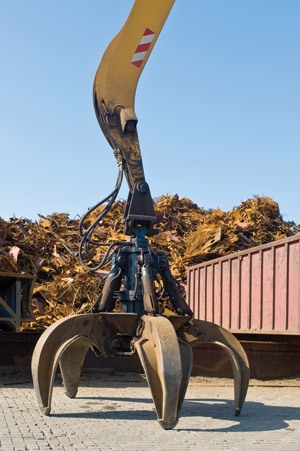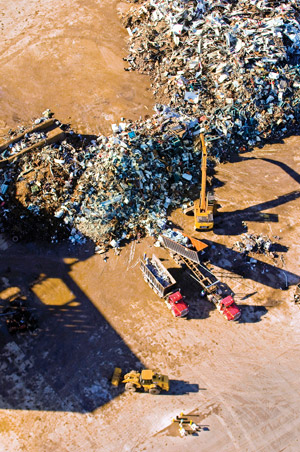Recyclers, service centers, utilities and communities raise the stakes against metal theft
Recyclers, service centers, utilities and communities raise the stakes against metal theft
January 2015 - Last July, Pacific Steel and Recycling in Elko, Nevada, responded to a Scrap Theft Alert issued by the county sheriff’s department regarding 1,800 pounds of stolen copper wire valued at $6,800. Pacific provided crucial information to the sheriff’s office, which was able to recover most of the wire in spite of the fact the wire was cut and stripped. The scrapyard also helped deputies identify the suspects.
“The reward outweighs the risks” for most thieves, which is why, despite metal theft laws enacted in all 50 states, the cost of copper theft has been estimated at $1 billion, says Brady Mills, director of law enforcement outreach for the Institute of Scrap Recycling Industries (ISRI), Washington, D.C., citing a U.S. Department of Energy study.
ISRI has no value estimates for the other metals stolen annually. However, Modern Metals totaled up the values of stolen metal listed in Scrap Theft Alerts issued just during October: $644,240. To boot, countless law enforcement agencies haven’t yet adopted the notification system.
“There is no uniform reporting category for metal theft for any but the largest cities so it is hard to come up with numbers,” Mills says. The value of the metal is but little compared with the damage caused when thieves steal from utilities, homes under construction, businesses and communications systems. One county’s emergency management department lost communication when thieves stole landline telephone wiring.
In many instances, says Mills, thieves “took $100 or $200 worth of copper but caused thousands of dollars of damage to get to  the metal. Depending on the age of the infrastructure and the prices of copper, it usually has to be replaced at higher cost.”
the metal. Depending on the age of the infrastructure and the prices of copper, it usually has to be replaced at higher cost.”
ScrapTheftAlert.com went live in 2008 and in March 2014 underwent upgrades based on feedback from users. Nearly 15,800 alerts have been issued, the system has nearly 18,600 active users and, based on voluntary reporting, roughly $1.6 million in stolen property has been recovered.
Recyclers are typically aware of items that are not normally scavenged. But often, stolen items are altered. “We might have a report of a 2,000-foot spool of wire but it has been cut into shorter lengths, compacted and taken to different recyclers,” explains Mills.
Communication is key
Schnitzer Steel Industries, Portland, Oregon, operates scrapyards all over the country. Colin Kelly, director of public affairs, serves as president of ISRI’s New England chapter.
“We are a big supporter of communication between law enforcement and scrap metal dealers. Without that, this problem is not going to get solved, no matter what laws are enacted.”
Schnitzer won’t complete a transaction without getting the seller’s identification. “We photograph every load coming into delivery in its entirety. On nonferrous scales, we take pictures of individual items on the scale. If there is a mixed load of scrap brass and aluminum, each metal gets weighed separately and photographed. We keep the pictures on file in case police need them. We work together to help them identify suspects.”
Simply brilliant solutions
Several years ago, there was a rash of thefts of air conditioner coils from homes in one Southeast city, Kelly recalls. Homeowners were advised to spray paint their AC units with different fluorescent colors. Police were then able to identify which neighborhood a coil came from when it was recovered. The fluorescent paint identification also worked well when thieves were breaking into foreclosed homes and stealing everything, he recalls.
Schnitzer works with Southwire, a Carrolton, Georgia-based copper cable producer. It has a cable and wiring product line called Proof Positive, on which it applies a unique serial number that provides proof of ownership for traceability. Material can be returned to the utility from which it was stolen.
“The Proof Positive wire is a big win to cut down on theft. You put that serial number in, and see that wire should be on a job site,” Kelly says. Schnitzer has even partnered with Southwire to conduct training at yards in states where that product is sold.
Kelly receives scrap theft alerts and sends out local reports to front-line managers.
“If a new vendor comes to the gate and asks how much his suspect material is worth, we’ll notify police that we have a suspicious load. We record the license plate in case the person runs off when we ask for ID. This builds the case,” says Kelly, both for locating the material and prosecuting the thief.
Another solution Schnitzer developed with local law enforcement is a tracking device. This was used in Wellesley, Massachusetts, a college town where bikes were being stolen daily. Police put decoy bikes on the street with the tracking device. “One was stolen within a few hours. Police followed the device and apprehended a bicycle theft ring. We are actually looking at those devices for other applications,” Kelly notes.
Red flags
“Items that throw up a red flag occur when, say, John Q. Public comes in with street signs or highway guardrail. We ask them where they got that. In some states, public property must have a letter of destruction from the contractor replacing the infrastructure. We expect to see a utility bring in sewer covers, but we want to make sure the seller is the right seller.”
Even industrial scrap sellers “may have a rogue employee stealing from them and we are paying them. We have a way for industrial accounts to see the tickets they enter in the system by the end of business day so they can make sure the quantities look correct.”
Commodities hard to track
One difficult issue for recyclers is identifying common products, such as copper pipes found in the vast majority of residential and commercial plumbing systems or coil edge trimmings, both of which are not typically traceable.
“We have found you cannot really prosecute unless you have cameras and the thieves are caught red handed with the material,” says William Vitucci, vice president and chief financial officer for Vitco Steel Supply, Posen, Illinois.
Even if they sold the material to a scrapyard and have a receipt, he says, “there’s no way to know where the scrap was generated or who had ownership of it.”
On the positive side, there are limits to cash payments now and thieves must be paid in traceable checks if they reach a certain threshold, says Vitucci. “You cannot just roll up in a truck and have 10 tons and get paid cash for it. You would not generate that much scrap if you’ve replaced your own hot water pipes or siding.”
Preventive measures
Two years ago, Vitco Steel was losing “800 to 1,500 pounds of scrap per week. We didn’t realize it because there was a lag in the reporting of weights” by Vitco’s recycler. Vitucci soon compared weights against payments and worked with the recycler to find out what was happening.
“The police caught the guys on our property but they didn’t have any product in their vehicle and there was no video camera proof,” he recalls. So now, Vitco covers its scrap bins at night with heavy channels or plate that require a forklift to remove.
During 2013, Christy Metals in Northbrook, Illinois, began noticing material missing from its tin plating operation. Over time, losses reached $100,000. “So we set up cameras throughout the facility,” says Vice President Lance Shelton. “We watched video of an individual take material at night. It was a manager. The police worked with us, setting up surveillance.
“The police watched him go to a scrap company and sell it for cash. They arrested him. The scrap company worked with us and provided us with all the times he had been there doing transactions, back over a year. He worked for our company 17 years so we suspect the thefts went back further,” Shelton says.
Now, Christy Metals backs up its videotapes and reviews them whenever material is short. It also insists that customers sign for deliveries that the material they ordered is on the truck, and checks the signatures.
Farmers Copper Ltd., Galveston, Texas, is also “concerned about hiring trustworthy employees,” co-president Dicky Farmer says.
Like Christy Metals, “when we make deliveries, we know exactly what’s on the truck and supervisors check to make sure nothing extra was loaded.” Select individuals are allowed to close the facilities at night. “We store nothing outside. We’ll make room to get product inside the building. We use cameras, alarms, all security systems,” says Farmer. And the company is “well acquainted with local law enforcement.”
O’Neal Industries, Birmingham, Alabama, has found security cameras to be helpful. “We had a few instances of people breaking into facilities and we were able to catch them,” says Jim Huntsinger, director of internal audit.
“The cameras are a great deterrent, as are having signs in a facility warning people that they’re being monitored and having fences with locked gates. We also have good controls, like monitoring inventory adjustments. We do prosecute thefts when we find out about them. We work with local jurisdictions and provide information,” he says.
Meanwhile, ISRI’s Mills is on a mission to educate recyclers and law enforcement of the many tools available to prevent and prosecute metal thefts. MM












